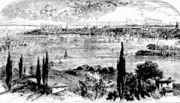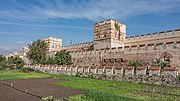Search results
Appearance
The page "Constantinople system" does not exist. You can create a draft and submit it for review or request that a redirect be created, but consider checking the search results below to see whether the topic is already covered.
- Constantinople (see other names) became the capital of the Roman Empire during the reign of Constantine the Great in 330. Following the collapse of the...132 KB (11,627 words) - 08:59, 15 June 2024
- The fall of Constantinople, also known as the conquest of Constantinople, was the capture of the capital of the Byzantine Empire by the Ottoman Empire...113 KB (12,836 words) - 11:53, 20 June 2024
- Ecumenical Patriarch of Constantinople (Greek: Οἰκουμενικός Πατριάρχης, romanized: Oikoumenikós Patriárchēs) is the Archbishop of Constantinople and primus inter...29 KB (3,212 words) - 10:47, 28 April 2024
- The Ecumenical Patriarchate of Constantinople (Greek: Οἰκουμενικὸν Πατριαρχεῖον Κωνσταντινουπόλεως, romanized: Oikoumenikón Patriarkhíon Konstantinoupóleos...81 KB (8,533 words) - 00:22, 19 June 2024
- Latin Empire (redirect from Latin Empire of Constantinople)The Latin Empire, also referred to as the Latin Empire of Constantinople, was a feudal Crusader state founded by the leaders of the Fourth Crusade on lands...34 KB (4,144 words) - 20:48, 10 June 2024
- History of Istanbul (redirect from Constantinople during the Ottoman period)Constantinople functioned as the capital of the Byzantine Empire, which effectively ended with the fall of Constantinople in 1453. Constantinople then...51 KB (5,902 words) - 01:20, 22 May 2024
- The second Arab siege of Constantinople was a combined land and sea offensive in 717–718 by the Muslim Arabs of the Umayyad Caliphate against the capital...52 KB (6,562 words) - 02:11, 8 June 2024
- The Walls of Constantinople (Turkish: Konstantinopolis Surları; Greek: Τείχη της Κωνσταντινουπόλης) are a series of defensive stone walls that have surrounded...114 KB (14,493 words) - 19:16, 17 June 2024
- The Synod of Constantinople in 1484 was a local synod of the Eastern Orthodox Church. It was the first synod to condemn the Council of Florence. After...4 KB (496 words) - 23:45, 30 January 2022
- The 1876–77 Constantinople Conference (Turkish: Tersane Konferansı "Shipyard Conference", after the venue Tersane Sarayı "Shipyard Palace") of the Great...16 KB (1,290 words) - 15:34, 13 May 2024
- Byzantium (redirect from Ancient constantinople)and later a Greek city in classical antiquity that became known as Constantinople in late antiquity which is known as Istanbul today. The Greek name Byzantion...22 KB (2,476 words) - 20:06, 25 April 2024
- The Eastern Schism, also known as the 2018 Moscow–Constantinople schism, is a schism between the Russian Orthodox Church (ROC, also known as the Moscow...215 KB (18,637 words) - 02:51, 14 May 2024
- semaphore system of beacons to transmit messages from the border with the Abbasid Caliphate across Asia Minor to the Byzantine capital, Constantinople. According...5 KB (589 words) - 20:09, 7 April 2023
- Hagia Sophia (redirect from Hagia Sophia, Constantinople)was reclaimed in 1261 and remained Eastern Orthodox until the fall of Constantinople in 1453. It served as a mosque until 1935, when it became a museum....228 KB (25,724 words) - 20:42, 18 June 2024
- The Great Powers ratified the terms of the Constantinople Arrangement in connection with the border between Greece and the Ottoman Empire in the London...4 KB (407 words) - 16:55, 22 September 2023
- Turkish: Bayrampaşa Deresi) is a stream, now vaulted over, that flowed in Constantinople (today's Istanbul), which was important for historical reasons. The...10 KB (1,069 words) - 10:20, 13 June 2024
- Istanbul (redirect from Constantinople (Turkey))(Ancient Greek: Νέα Ῥώμη Nea Rhomē; Latin: Nova Roma) and then finally as Constantinople (Constantinopolis) after himself. In 1930, the city's name was officially...221 KB (21,526 words) - 00:13, 19 June 2024
- Roman Empire, was the continuation of the Roman Empire centered in Constantinople during Late Antiquity and the Middle Ages. The eastern half of the Empire...177 KB (19,539 words) - 17:57, 15 June 2024
- The ancient city of Constantinople was divided into 14 administrative regions (Latin: regiones). The system of fourteen regiones was modelled on the fourteen...25 KB (3,040 words) - 07:51, 5 May 2024
- (patriarchs) of the five major episcopal sees of the Roman Empire: Rome, Constantinople, Alexandria, Antioch, and Jerusalem. The idea came about because of...42 KB (4,807 words) - 04:00, 4 June 2024
- 7 Constantinople by Alexander van Millingen 17436431911 Encyclopædia Britannica, Volume 7 — ConstantinopleAlexander van Millingen CONSTANTINOPLE, the
- Istanbul (redirect from Constantinople)Istanbul, formerly known as Constantinople, is the most populous city in Turkey. Istanbul is a transcontinental city in Eurasia, straddling the Bosphorus
- in Constantinople. He dreamed of reconquering the lands of the Western Roman Empire and ruling a single, united Roman Empire from Constantinople. He


















